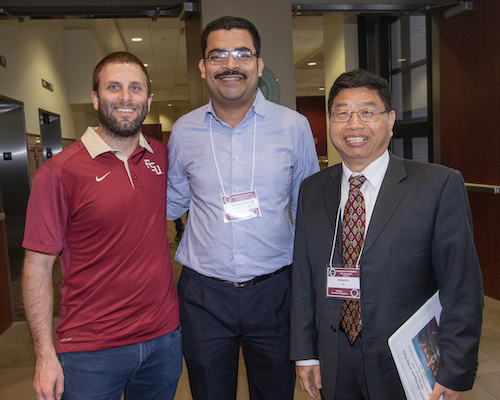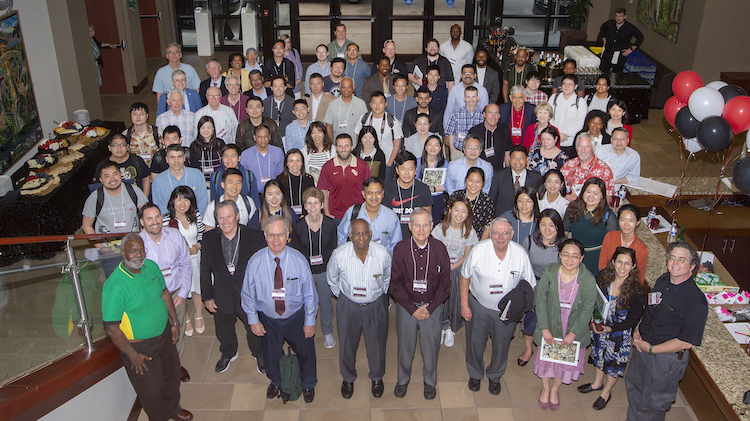Statistically significant - Big Data is a big deal as FSU statistics turns 60

60th anniversary.
Every day, unprecedented quantities of data are collected across nearly every facet of modern life. Those who can extract valuable information from the trove in this era of Big Data are in high demand.
Last year, the Florida State University Department of Statistics had 200 graduate students, making it the largest graduate program in the entire College of Arts and Sciences. The number decreased slightly to 180 in 2019, but it’s still at the top with the college’s other large graduate programs such as chemistry and psychology. This year, there are 120 undergraduate majors.
But the world was a different place in September 1959, when professor Ralph A. Bradley came to the university to serve as the new statistics department’s first chair. His staff at the time consisted of two math professors who weren’t all that interested in statistical research.
Much of the growth in the intervening six decades was propelled by the introduction of computers to the discipline. Jayaram Sethuraman, a retired professor and former department chair, recalls the early 1970s, when statisticians struggled to work with first-generation computers. Once computers became more user friendly, the whole field of statistics essentially became computational, he explained.
“Now, more complicated applied problems can be handled with statistics. Everybody collects data, and everybody wants to find out something from the data — and statistics is providing solutions,” Sethuraman said.
The work computers perform today is based on years of tried-and-true theories developed by statistical researchers, he continued.
“As an applied field it’s very important. Every field of human endeavor requires statistics now,” he said. “Applications are so financially rewarding you sometimes forget about the statistics. We proved them with theory, we proved that they’re going to work, but you now have all the data that could use that theory.”
Daniel McGee, who came to FSU in 2002 after previous careers in the U.S. Public Health Service and academic medicine and served as a professor and department chair in statistics, similarly described the evolution of the discipline.
“I am fond of saying what we call data scientists today are what we used to call applied statisticians,” said the 77-year-old, who retired in May after teaching his last class during the spring semester. “When I came here, we had eight undergraduates, and now we’re over 100. The field of statistics has been on a 60-year upward trend.”

pose for a photo with Department of Statistics Chair Xufeng Niu at the
60th anniversary celebration.
The chance to reminisce about the journey and reconnect with those who shaped the department were at the heart of a reunion that brought together 165 returning alumni, faculty, students and friends at FSU’s Turnbull Conference Center in April.
Three generations mingled and celebrated the department’s diamond anniversary — classmates from years past, professors and former students, current students, as well as professionals from a broad cross-section of industries. Attendees were invited to present their work, the results of which demonstrated the breadth of applications for statistics, including biomedicine, airlines, educational testing, physical science and insurance.
A. Blanton Godfrey, who earned his doctorate from FSU in 1974, showed the worldwide impact of statistical analysis in his presentation on reducing maternal and child mortality. He now teaches at North Carolina State University.
Making a pitch for a statistics-related career at the CIA was Barbara Stevens, who earned her doctorate from FSU in 1985 and now serves as chief of data science for the intelligence service.
Former Iceland Minister of Defense and alumnus Benedikt Jóhannesson described how his doctorate informed his time in that role.
“In our mathematical world, we often search for optimal solutions. In the real world, such a solution may not exist, and even if it does, we can never be sure we found it,” he said. All three are graduates of the program from before the last decade of exponential growth that saw undergraduate and graduate student ranks increase sixfold and threefold, respectively.
“Everybody is interested in analytics now. But I think the growth in the department reflects the robust and diverse training the department has provided students,” said Tim Logan, associate dean of the college. “The size of this gathering really reflects the sense of community current and past students and faculty have from this department. I commend you all for contributing to this growth.”
Current department chair Xufeng Niu credits strong support from the college and university, especially from the college’s dean, Sam Huckaba, for the department’s decade of rapid ascent.
“The graduate program in my department is one of the most diverse programs in the nation,” Niu said. “For future development, my department will continue focusing on interdisciplinary research, advancing innovative statistical methodology and application, and producing high-quality graduates with B.S., M.S. and Ph.D. degrees for the state of Florida and for the nation.”


